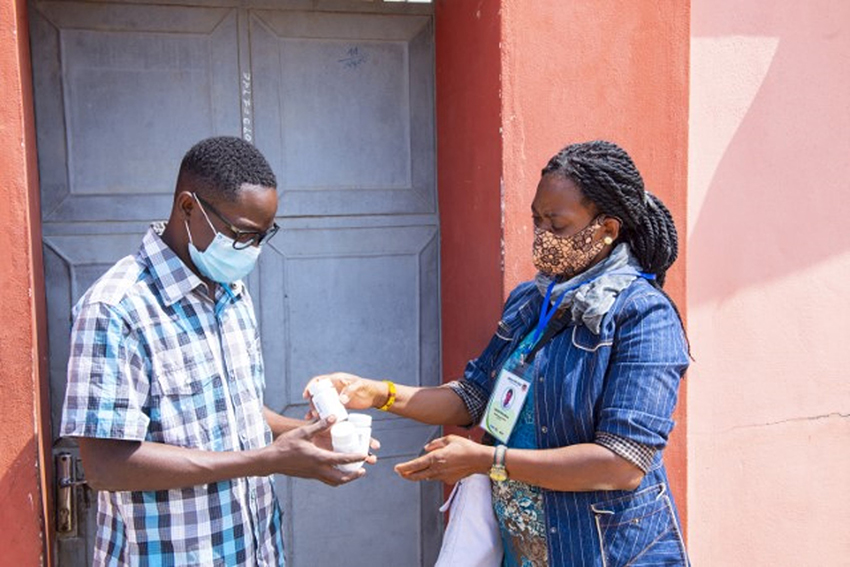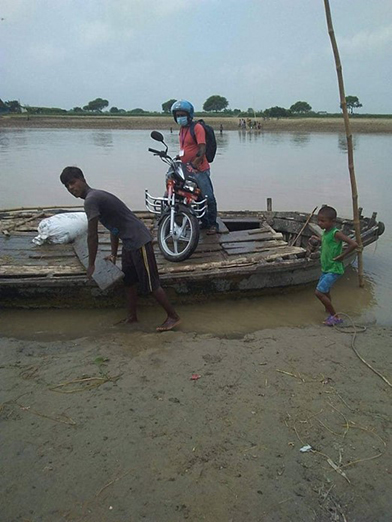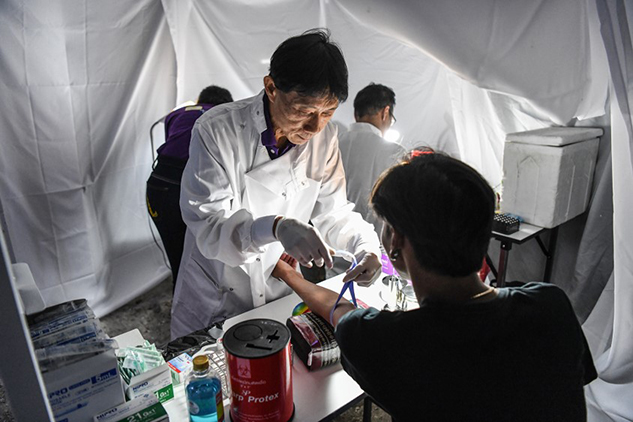
A peer navigator from Espoir Vie Togo participates in the community-based distribution of antiretroviral treatment during the COVID-19 pandemic. The distribution was done in association with the Ending AIDS in West Africa project led by FHI 360. Photo credit: Raymond Varvatos Avosseh for FHI 360.
Over the past decade, there have been remarkable advances in the HIV prevention, treatment and epidemic control tools used by the global community working to address HIV. Investments in scientific discovery and implementation research have furthered our understanding of the factors driving the epidemic, as well as the biology of viral transmission. Prevention, diagnostic and treatment strategies have improved immensely, as have antiretroviral drugs.
Still, after 40 years, HIV remains a major global health crisis: In 2020, there were 680,000 AIDS-related deaths and 1.5 million people newly infected with HIV, far off the UNAIDS targets for epidemic control. While some countries were able to leverage recent advancements and are at or near epidemic control (when the total number of new HIV infections falls below the total number of deaths from all causes among people with HIV), other countries remain far from that goal.
Since 2020, the COVID-19 pandemic has disrupted HIV services globally, threatening to reverse the gains of the recent past. The global community working to address HIV was forced to adapt, and the resulting innovations yielded substantial benefits for people living with — or who were at risk of contracting — HIV.
The innovations that resulted from the COVID-19 pandemic improved our available toolkit. The experience should serve as a reminder that we need differentiated service delivery models — not just a one-size-fits-all approach — to successfully control the HIV epidemic.
Adaptations to COVID-19 accelerated differentiated service delivery for HIV programs
During the COVID-19 surges and lockdowns, health care professionals in the HIV field were often pulled into COVID-19 service delivery, and people living with HIV were discouraged from visiting clinics and hospitals to avoid COVID-19 infection risk. Emergency public health measures halted many community-based services, particularly HIV testing and group education activities.
To address these gaps, numerous global program implementers scaled up creative differentiated and decentralized service delivery models. Antiretroviral treatment (ART) and HIV self-test kits were delivered by motorcycle or through the post, and community ART pickup services became available at central locations or lockers. The use of telehealth expanded rapidly to serve HIV clients along the continuum.

The motorbike of a peer navigator from the NAMUNA Integrated Development Council is transported by boat to a village in Nepal; the motorbike will be used to deliver antiretroviral treatment to people living with HIV during the COVID-19 pandemic. NAMUNA works with EpiC Nepal as an implementing partner agency. Photo credit: EpiC Nepal for FHI 360.
In the greater Jakarta area of Indonesia, motorcycle delivery services provided drugs for 5,000 patients in need of ART during March to December 2020, through FHI 360’s Meeting Targets and Maintaining Epidemic Control (EpiC) project, which is funded by the U.S. Agency for International Development. As essential services that were exempt from public transport restrictions, private sector services were well-placed to support home delivery of ART. During April to November 2020, more than 50% of people in need of ART in Mbo LGA of Akwa Ibom State, Nigeria, received home delivery of drugs from community health workers. As a result, 99% of those ART patients continued to receive treatment during that period.
Though these service delivery initiatives originated from the need to adapt to COVID-19 shutdowns and restrictions, scaling them up sustained HIV services for people living with or at risk of contracting HIV. Furthermore, the need to adapt to COVID-19 showed how these services could be improved using differentiated service delivery models. Delivery of ART at home or at convenient community locations proved to be a feasible — and even preferrable — approach. The telehealth boom made HIV services available to people previously un- or underserved.
Differentializing provides more choices to and better coverage of populations that providers have previously struggled to reach. Even in countries that are closer to reaching epidemic control targets, services are not reaching all who need them. Key populations, such as men who have sex with men, adolescent girls and young women, still have much higher rates of new infections and much lower rates of treatment adherence and viral suppression. A differentiated approach ensures that everyone can access a prevention, diagnostic or treatment option that works for them.
Sustained epidemic control via differentiated service delivery models
Today, the global community working to address HIV is actively developing models for sustained epidemic control, with a country-owned response at the center. These developments are important and necessary; however, many of the models being proposed for this new phase of the HIV response are a return to the one-size-fits-all approach.

In Thailand, a mobile clinic for HIV testing is set up adjacent to a secluded bar where transgender people and men who have sex with men socialize. Photo credit: Jirantanin Tanachoknantaphat/Mplus Foundation.
To achieve epidemic control, countries must include differentiated service delivery models in addition to traditional health care system models. This approach is necessary for continued and expanded engagement of vulnerable populations who may not be served effectively through traditional facility-based primary health care models. Even as we face a new phase of the epidemic, in which governments are funding more of their own HIV response, social financing for community-based services cannot be neglected.
The adjustments and innovations required to maintain HIV programs during COVID-19 lockdowns highlighted the need for and value of a flexible and creative HIV response. In adapting to a changing environment, we met people where they were and found solutions to persistent, thorny challenges of access.
If, in addition to establishing facility-based services that meet the needs of the majority, national HIV responses prioritize and expand the differentiated and decentralized care initiatives that were so adaptable during COVID-19 lockdowns, we can meet the challenge of epidemic control. Then, the goal of no one left behind comes closer to reality.
